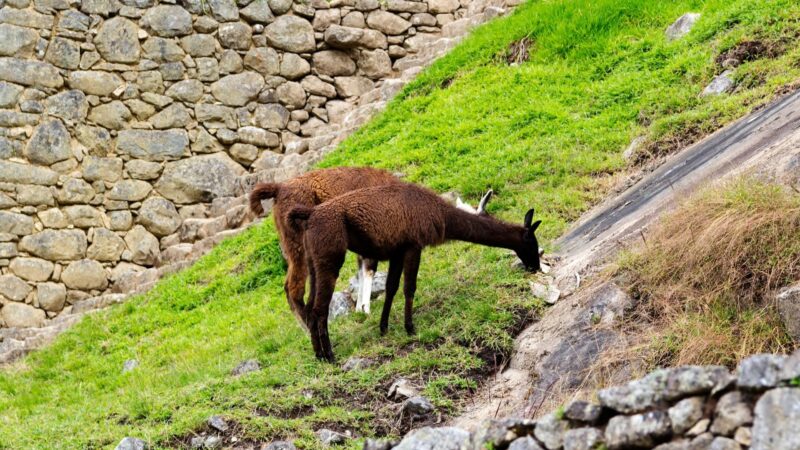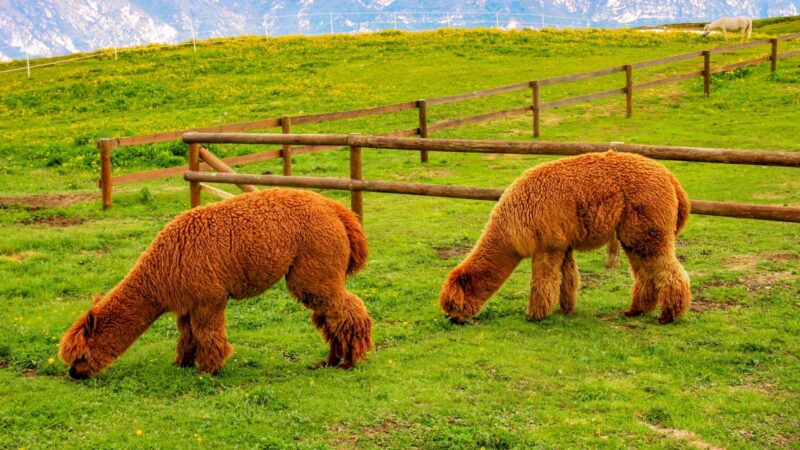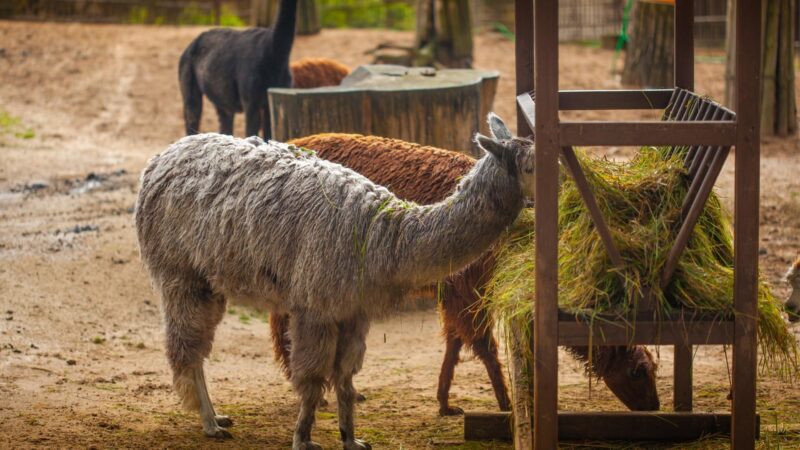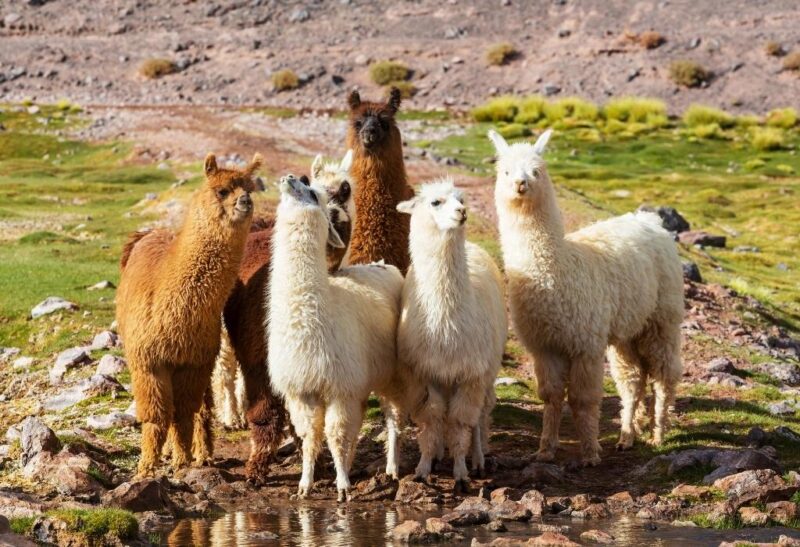Llamas belong to the Camelid family, and they’re natives of South America. They were considered wild exotics in the past, but these domesticated animals have also grown in number in the United States.
Their estimated number is from 70,000 to 90,000. The high population is proof that the growers have been providing these animals with good nutrition.
Llamas’ favorite foods are carrots, celery, parsnips, and sweet potatoes. They also like fruits, specifically bananas, apples, mangoes, oranges, and watermelon. Hence, these vegetables and fruits are made into Llamas’ treats.
Apart from a balanced diet of grass and shrubs and supplements, giving llamas these treats is a way to provide more vitamins and nutrients. Receiving treats once in a while can also make them happy. To learn more about the right diet for llamas to grow healthy, read the article.
Table of Contents
What Do Llamas Eat?

Llamas are considered modified ruminants because their stomachs have only three compartments. The tree ruminants like cows, sheep, and goats have stomachs with four compartments. Nonetheless, llamas have an efficient digestive system. They can survive with a small ration of low protein feed.
However, llamas primarily eat grass hay, pasture green, or a mix of grass hay and alfalfa. Although hay and straw are types of roughage, it helps the digestive system of llamas to work well. In winter, corn or a mixture of corn and oat is helpful for pregnant and nursing llamas.
Llamas can also have supplements called ‘llama pellets.’ A bag of these pellets has the same price as a bag of oats. Purina Animal Nutrition and Mazuri Care Pellets are excellent llama pellets that you can feed your llamas.
- Designed to maintain adult alpacas and llamas in good body...
- Complements grass or legume hay or pasture
- Contains added vitamin E and selenium
- Reduces need for supplements
- Not suitable for growing, gestating, lactating, or fiber animals
There are different reasons why people raise these animals, so they may not always need to give llamas supplement. Supplements may be essential for owners who have llamas for breeding and selling llamas. The basic diet may be fine for those who own llamas as pets.
What Do Llamas Eat in the Wild?
Llamas eat grass in the wild and some plants, including flowering ones. They may eat leaves, needles, bark, roots, and tubers. Therefore, llamas can survive by eating various kinds of plants. They only need to drink a little water, so they’re hardy animals that can adapt to mountainous terrain well.
Do Llamas Eat Meat?
Since llamas are herbivores, they don’t eat meat.
How Much Should Llamas Be Fed?

One llama needs food weighing 1 to 2 percent of its weight daily. For example, a llama that weighs 300 pounds should be fed 3 to 6 pounds of hay. You may think it’s a small amount of food, but it’s sufficient for this animal. The daily amount of feed always depends on the animal’s weight.
When you can place the llamas on a pasture, which is possible in summer, they will be fine without other types of food. If ever you change their diet, it should be done gradually to avoid disturbing their digestive system.
More food can be given to them when they do hard work and during winter days. You can also ask for advice from experienced llama breeders and veterinarians regarding the recommended diet for llamas.
How Do Llamas Get Their Food?
Just like cattle, llamas graze on grass. These animals regurgitate their food and chew it to turn it into cud. They take some time chewing and chomping wads before swallowing to achieve complete digestion.
What Do Llamas Eat for Treats?

There are certain types of fruits and vegetables that llamas can eat as treats. They’re safe and healthy for these animals. But you have to be attentive with the preparation so they won’t choke. You have to chop carrots, celery, and parsnips into small pieces.
In the case of small potatoes, cut them into small cubes with the peel on or removed. To make a warm and soft treat, boil the chopped sweet potatoes, carrots, and parsnips. This warm treat is ideal for cold days. It also suits llamas that have difficulty chewing hard food, and this treat comes gently on their teeth.
If you decide to give them fruits like oranges, mangoes, apples, watermelons, and bananas, you have to chop them into small pieces. It will reduce the chewing time and prevent the llamas from choking.
Do People Eat Llamas?
The domestication of llamas in South America started thousands of years ago. Aside from being utilized as pack animals and a source of wool, they’re a protein food source in the regions of their origin. Llama meat can be consumed fresh right after the slaughter.
The llama meat is lean with pinkish and white colors and a spongy texture. Intestines and blood are made into dishes that are similar to haggis. The llama meat is also preserved to b sold in other markets. It’s cut into thin strips and soaked in brine for a couple of days.
How Much Does It Cost to Feed a Llama?

The feed for a pair of llamas would cost $350 annually. This amount will compensate for the pellet supply enough for two llamas and the amount of hay good for 6 months.
The given budget is when you put your llama on posture for half a year. Llama owners may have different beliefs on the feeding method, so the budget depends on the feeding pattern.
What Not to Feed Llamas?
Although several fruits and vegetables can be given to llamas as treats, some things are not meant for them. Some foods can cause allergic reactions and even severe toxicity. They can have the worst adverse effect by ruining the overall health of a llama in the long run. Here’s the list of food not allowed for llamas:
- Avocados
- Chocolates
- Stone fruits like plums, peaches, and cherries
- Eggplants
- Animal products
- Potatoes
- Peas
- Lima beans
- Processed, sugary food of humans
Llamas shouldn’t eat sugary foods because their stomach is not made for digesting a high amount of sugar, starch, and complex carbohydrates. Bear this in mind to avoid giving your llamas food that is not good for their system.
Veterinary Medicine of the OSU College made a study about how llamas, as well as alpacas, become diabetic. It’s done because llamas’ metabolism is similar to a diabetic person.
Frequently Asked Questions
What Is Llama Good For?
Llamas are profitable in the market as you can sell them alive and make money from their fiber. This is turned into woven and knitted items. As mentioned, these animals can also be a food source. They can be cart-pulling animals as they’ve been used for transport in mountainous areas.
Llamas are adorable. They are in pet therapy programs that are held in schools and nursing homes. Since they’re social, they can be made into herd guards. You can train them to treat herds of goats or sheep as their own, so they’ll chase predators away.
What Are Llamas Predators?
The llamas’ predators are coyotes, ocelots, and mountain lions.
Do Llamas Like to Eat Alfalfa?
Llamas like to eat alfalfa. But responsible owners should be aware of the effects. Alfalfa hay can cause urinary issues and lead to fatality. Some owners only choose to feed alfalfa to the underweight llamas and the females that are pregnant or lactating. Still, you must seek advice from a veterinarian regarding feeding alfalfa to your llamas.
Do Llamas Eat Hay?
Llamas eat hay, especially the ones in the United States, as it becomes their staple diet. Hay is highly available in regions where plant materials are scarce. Also, the pasture is buried in the snow for several feet in winter.
Are Llamas Good to Eat?
Llamas are good to eat because it’s lean meat which means they are healthier. To be exact, it has a high protein content and low cholesterol. The taste is somewhere between lamb and beef. Llama meat is patronized in the UK as it’s described as sweet and succulent.
However, illegal import of meat in the UK is common, and the meat can be unsafe. The government has warned its people about health risks. They can’t be sure about the safety of the meat that they eat if it doesn’t go through regulations.
Summary
Llamas are from the mountainous regions of South America. They’re distinguished as hardy animals, so their diet does not consist of a heap of foods. This means that owning one or more is relatively affordable.
Since llamas are modified ruminants, you have to be careful with what they give them, as well as the amount of food. You don’t want them to give in to allergic reactions and toxicity.
List of Sources
Gegner, L. (2012). Llamas and Alpacas on the Farm. National Sustainable Agriculture Information Service.
Trombley, J. Foods Indigenous to the Western Hemisphere. American Indian Health and Diet Project.
Portman, C. (2004). Lama glama. Animal Diversity Web.
Llama Project Handbook. (2008). University of Wisconsin-Madison – Extension Sheboygan County.

